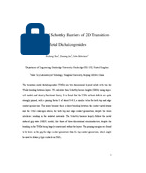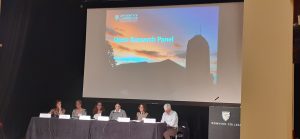This blog post looks at a recent feature implemented in our repository called ‘Request a copy’ and discusses the process and management of the service. There is a related blog post which discusses the uptake and reaction to the facility.
As part of our recent upgrade to the University’s institutional repository (now renamed ‘Apollo‘), we implemented a new feature called ‘Request a copy’. ‘Request a copy’ operates on the principle of peer-to-peer sharing – if an item in Apollo is not yet available to the public, a repository user can ask the author for a copy of the item. Authors sharing copies of their work on an individual basis falls outside the publisher’s copyright restrictions; here, the repository is acting as a facilitator to a process which happens anyway – peer to peer sharing.
The main advantage of the ‘Request a copy’ feature is to open up the University’s most current research to a wider audience. Many of our users do not necessarily come from an academic background, or may be based within another discipline, or an institution where journal subscriptions are more limited. The repository is often their first port of call to find new research as it ranks highly in Google search results. We hope that these users will benefit from ‘Request a copy’ by being able to access new outputs early, at researchers’ discretion. Additionally, this may provide an added benefit to researchers by introducing new contacts and potential collaborations.
How it works
 Items in Apollo that are not yet accessible to the wider public are indicated by a padlock symbol that appears on the thumbnail image and filename link which users can usually click to download the file.
Items in Apollo that are not yet accessible to the wider public are indicated by a padlock symbol that appears on the thumbnail image and filename link which users can usually click to download the file.
Reasons why the file may not yet be publicly available include:
- Some publishers require that articles in repositories cannot be made available until they are published, or until a specified time after publication
- We hold a number of digitised theses in the repository, and for some we have been unable to contact the author to secure permission to make their thesis available
- Authors may choose to make their dataset available only once the related article is published
When a user clicks on a thumbnail or filename link containing a padlock, they are directed to the ‘Request a copy’ form. Here, they provide their name, email address and a message to the author. On clicking ‘Request copy’, an email is sent to the person who submitted the article, containing the user’s details. The recipient of this email then has the option to approve or deny the user’s request, to contact the user for more information, or (if they are not the author) to forward the request to the author.
How it really works
In practice, the process is slightly more complicated. For most of the content in the repository, the person who submitted an item will be a member of repository staff, rather than the item’s author. This means that for the most part, emails generated by the ‘Request a copy’ form were initially sent to members of the Office of Scholarly Communication team. In some cases, these requests were sent to people who have left the University, and we have had to query the system to retrieve these emails. As an interim measure, we have now directed all emails to support@repository.cam.ac.uk. These still need manual processing.
Theses
For theses where we have not received permission from the author to make them available, we forward requests to the University Library’s Digital Content Unit, who have traditionally provided digitised copies of theses at a charge of £65. We have found however, that once information about this charge is communicated to the requester, very few (approximately 1%) actually complete the process of ordering a thesis copy.
We have been working with the Digital Content Unit on a trial where thesis copies were offered at £30, then £15. However, even at these cheaper prices, uptake remained low (it increased to 10%, but due to the small size of the sample, this only equated to two and three requests at each price point, and therefore may not be statistically significant). This indicates that the objection was to being charged at all, rather than to the particular amount. Work in this area remains ongoing to try and offer thesis copies as cheaply as possible to requesters, while allowing the Digital Content Unit to cover their costs.
Articles
If the request is for an article, we first need to check whether the article has actually been published and is already available Open Access. Although we endeavour to keep all our repository records up to date, unless we are informed that an article has been published, repository staff need to check each article for which publication is pending. This is a time-consuming manual process, and when we have a large backlog, sometimes it can take a while before an article is updated following publication.
If we found that the article has indeed been published and can be made Open Access, we amend the record, make the article available and email the requester to let them know they can now download the file directly from the repository.
On the other hand, if the article is still not published, or if it is under an embargo, we need to forward the request to the corresponding author(s). Sometimes their name(s) and email address(es) will be included within the article itself, and sometimes we have a record of who submitted the article via the Open Access upload form. However, if it is not clear from the article who the corresponding author is, or if their contact details are not included, and if the article was submitted by an administrator rather than one of the authors, we then need to search via the University’s Lookup service for the email addresses of any Cambridge authors, and search the internet for email addresses of any non-Cambridge authors, before we can forward on the request.
As a result, it can take repository staff up to 30 minutes to process an individual request. This is quicker if the article has been requested previously and the author’s contact details are already stored, but can take longer when we need to search. Sometimes, there is also repeat correspondence if the author has any queries, which adds to the total time in processing each request.
Amending our processes
Since introducing ‘Request a copy’, we have started collecting the email addresses of corresponding authors when an article is submitted, and we have commissioned a repository development company to ensure that ‘Request a copy’ emails can be sent directly to those authors for whom we have an email address – a feature that we are hoping to implement in the next few weeks.
However, if the author moves institution, their university email address will no longer be valid, and any requests for their work will again need to come via repository staff. One way to solve this would be to ask for an external (non-university) email address for the corresponding author at the point where they upload the article to the repository. However, this would introduce an extra step to an already onerous process and may act as a further barrier to authors submitting articles in the first place.
Generally, ‘Request a copy’ is a great idea and provides many benefits to the research community and beyond. But the implementation of this service has been challenging. The amount of time taken by each request has meant that some staff members have been redeployed from their usual jobs to facilitate these requests, which also has an impact on the backlog of articles in the repository that need to be checked in case they have since been published. If an article is published but still in the backlog (and therefore not publicly available in the repository), unnecessary requests for it could result in a reputational issue for the Office of Scholarly Communication and the University.
We will continue to look at our processes over the coming academic year, to see how we can improve our current workflows, and identify and resolve any issues, as well as determining where best to focus any further development work. In the related blog post on ‘Request a copy’, I’ll be talking about usage statistics for the service so far, some more unexpected use cases we have encountered, and feedback from our users that will help us to shape the service into the future.

